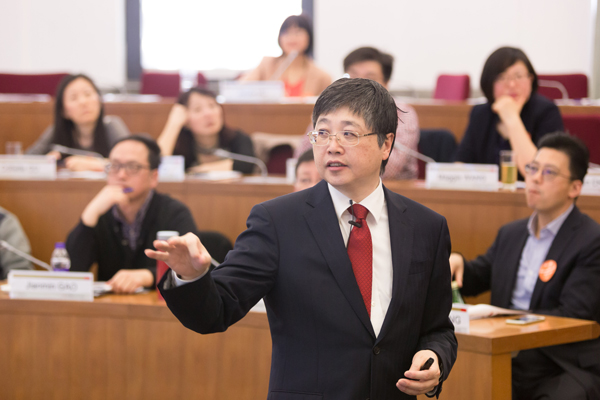Explainer: US-China Trade Spat

This is an excerpt from a March 31st lecture by CEIBS Professor of Economics Xu Bin in which he explains that Americans’ failure to save is the main reason for the US’ huge trade deficit with China. He also provides a theoretical framework on trade which provides valuable context for understanding the current tension between the two countries.
“In the ongoing trade spat between the US and China, the two sides do not agree on the actual size of the trade gap; but whether it is a $100 billion difference or not, you cannot miss the big picture. The US is running a huge trade deficit with China. It’s the biggest in the world.
In 2008, China’s trade surplus was close to 10 percent of the country’s GDP. At that time, American congressmen’s claims that China was manipulating its currency might have been valid. Now China’s trade surplus is 2.5 percent of its GDP. The international convention is that as long a country’s trade balance is within 3 percent of GDP, its exchange rate is considered to be close to equilibrium. Now the US has no actual statistical basis for saying China is still manipulating the renminbi rate.
So if currency manipulation isn’t the cause of the current trade deficit, what is?
For the answer to this question, you need to understand that a country’s overall trade balance equals the difference between domestic saving and domestic investment. Indeed this equation is an accounting identity that always holds. If a country saves more than it invests domestically, it will run a trade surplus. If a country saves less than it invests domestically, it will run a trade deficit. The US runs a trade deficit not because other countries are manipulating their currency but because Americans do not to save enough.
The other side of the coin is consumption. If you consume more, then you save less, and you are going to run a trade deficit no matter what. You can turn it around to have a trade surplus only if you change your saving behaviour to save more than domestic investment.
So, it is a domestic, internal reason that is behind the US’ trade deficit.
Similarly, China is running a trade surplus with other countries not merely because China devalues its currency, but mainly because Chinese people are at a stage where they have to take care of needs such as housing, medical, retirement as the social safety net for Chinese people is inadequate. They have to save a lot. So China runs a trade surplus.
Some say this tendency to save is part of Asian culture. I disagree. Japan used to have a trade surplus because, at that time, Japanese people saved a lot. Now, Japan has an ageing population. Old people think, “Why do I have to save? I am close to death soon. So I spend.” So now Japan is running a trade deficit. I do not deny that there may be a cultural element to this saving behaviour but it is not the main element. The main element is economics.
Bilateral trade
The difference between saving and domestic investment equals a country’s trade balance with all its trade partners, which we call the “overall trade balance”. For the bilateral trade balance, for example the one between China and the US, it depends on the real exchange rate (which equals the nominal exchange rate adjusted by the inflation rates of the two countries) and some “other factors”. In short, real appreciation of a currency makes exports more difficult, and real depreciation makes exports easier. But in the US, after year 2001, despite real depreciation of the dollar against other currencies, the US trade balance does not improve. Thus it is the “other factors”. What are these other factors?
The Americans think it’s China.
I think they may be right, because China entered the WTO in 2001 which made the country able to export more. When you export more, you accumulate more foreign exchange reserves. China invested more than one-third of its foreign exchange reserves in US treasury bills, it resulted in an increase in liquidity. Americans were already consuming too much. Now with this Chinese financing, they consumed even more. The data has shown it is true. Their savings rate became even lower. Some families even had a negative savings rate. This shows that if China had an impact on the rise of US trade deficit, it was not through the renminbi rate.
Meanwhile for China, the data shows that between 2001 and 2015, the renminbi’s real exchange rate against all other countries was appreciating. With this you would expect China’s trade surplus to go down. But that wasn't the case. Most of the time China’s trade surplus moves hand in hand with the RMB value. This shows that the exchange rate is also not the main factor in China’s trade surplus. The main factor, as discussed earlier, is that Chinese people are saving a lot, more than they invest domestically.
Overview of trade theory
Americans would argue, however, that the Chinese government’s intervention in foreign trade is the main reason for China to run such a big trade surplus, especially with the US. To understand today’s trade issues, one needs to understand the theory behind it all. The traditional trade theory is based on the concept of comparative advantage, which was developed by British economist David Ricardo and later enhanced by two Swedish economists Heckscher and Ohlin.
What is a comparative advantage? If I'm doing better than you in teaching, that is called an absolute advantage. If I'm better than you in drawing these graphs, it's also called an absolute advantage. If I have absolute advantage over you in all aspects, should I be your friend? The answer is yes. Because cooperation is not based on absolute advantage but on comparative advantage. That’s because everyone’s, or every country's, resources are limited.
If you have unlimited time to do things, then of course you do not have to work with anybody, you do everything by yourself. But your time is limited. So it's better to focus on what you do best. If the US can do everything better than China, it still would not want to do everything itself. It’s better to do aircrafts, for example, and one aircraft can then be exchanged for many, many, many toys and clothes.
In the 1980s, China was exporting labour-intensive goods. That's because its comparative advantage, at the time, was a lot of unskilled labour. Another comparative advantage was abundant capital, because China had a very high savings rate. On the other hand, China has a comparative disadvantage in skilled labour and technology. Data shows that China’s export patterns follow closely its comparative advantage; 70 percent of its exports were labour-intensive textiles, apparels and toys.
But comparative advantage is not static, it is dynamic, it evolves over time.
Japan started with exporting labour-intensive goods. Then it moved to capital-intensive goods, then technology-intensive goods. South Korea and Taiwan follow the same path and now China; this is the so-called East Asian Growth Model.
The fundamental reason for this is: a country’s comparative advantage evolves – for example, China is losing its comparative advantage in the labour force. Remember it is not about China's total amount of unskilled labour being now less than other countries. No, it's still big. But relatively speaking, China's young labour force is declining. So China is unable to maintain its export pattern in the labour-intensive products. Data shows that textiles and apparel exports now account for less than 20 percent of China’s exports, while machinery and equipment account for 70 percent.
This comparative advantage concept is the foundation of the old, traditional trade theory. It's still valid, but as the world develops, there emerged new trade theories.
Paul Krugman was given the Nobel Prize in economics because he developed a new theory which shows that there can be trade even if it is in the same type of goods, for example cars. Trade does not need to be derived from comparative advantage; it can also be derived from economies of scale and scope – which leads to intra-industry trade.
Krugman writes for the New York Times and is very strongly opposed to Trump. His New York Times columns basically say that Trump does not understand modern economic trade theory, a theory which basically proves that trade is good. However, there are some arguments in trade theory which show that trade protection can be beneficial. When we say beneficial, there are two layers of meaning: if you want to argue that trade protection is beneficial, you should not argue that it is beneficial to some people. You should argue that it is beneficial to the national welfare. There are two arguments which are based on national welfare, one is called the infant industry argument, the other is called the strategic trade argument.
Infant industry argument
Let’s say Britain has a well-developed textile industry and now the US wants to get into textiles as well. If the US opens its market completely to the British, its young textile industry will not be able to compete. So the US closes its doors to British textiles and only opens up after the US textile industry has grown up. Then they can both fight for market share. The theory was developed by one of America’s founding fathers, Alexander Hamilton. It was later promoted by Friedrich List, a German economist.
Strategic trade argument
The second argument against free trade is called the strategic trade argument, which was developed by two Canadian economists. It basically says that only one company can be making a profit in an industry with high scale requirement. Then if you are the first comer, like Boeing in the aircraft industry, you dominate. Their argument is that you can create Airbus and protect it with government subsidy, which will eventually shift the profit from Boeing to Airbus. This could be done on the grounds of national welfare. If Europe gives a subsidy to Airbus and drives Boeing out of the market, Europeans would benefit not just in terms of profits for Airbus, but also gains for Europe as a whole. .
The question is, over the last 30 years, has China developed its exports because of comparative advantage, economies of scale, or because of government policy? That’s the big question. If it was because of comparative advantage, that’s because of the market, that’s justified. If it’s because of a lot of government policies, say subsidies, then that is arguable. I think it was a bit of both, but mainly on the market side.
China is a good example of dynamic comparative advantage. Its export patterns evolved from labour-intensive goods to capital and technology-intensive goods. But you cannot deny that the Chinese government has provided support to Chinese exporters. However to be truly objective, a lot of the things the Chinese government supported actually failed, for example its subsidies to the solar panel industry. Most of the industries or companies that have been successful are from the market: Alibaba, Tencent, JD. But of course, there are some items or industries which the government will give subsidies, the government will have tax rebates etc. And those government policies impact trade, which is linked to the US concern over the trade imbalance between US and China.
But we should not over-estimate the importance of this US-China tariff issue. Many people seem to be saying that it is the end of world, the two biggest countries are having a trade war. But the fact is that this is just a small episode. It is more symbolic than real. But it reflects a very big message: the whole world is very scared by the rise of China. It is natural for the US, being the leader of the old world, to come out against China.
I think both sides are playing the game for their own goals. Trump’s interest is mainly in winning his domestic political battles. China is trying to be the next super power. I think China can compromise the short term for the long term. So China would never engage in direct conflict with the United States, even with domestic pressure. I expect the two countries will sit together to negotiate. They will both try to avoid a nuclear level fight, but fights between them will last for a long, long time.”













